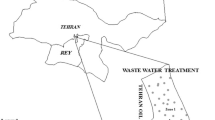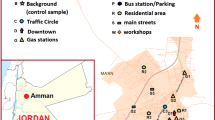Abstract
The analysis of aliphatic hydrocarbons, which are composed of n-alkanes as well as branched and cyclic alkanes, can be used to distinguish between the sources of hydrocarbon contamination. In this study, the concentration of aliphatic hydrocarbons, soil pH, and organic matter in agricultural soils located south of Tehran were monitored. Eighty-three soil samples were taken from two depth ranges of 0–30 and 30–60 cm. The results showed that aliphatic compounds ranged from 0.22–68.11 mg kg−1 at the top to 0.33–53.18 mg kg−1 at subsoil. The amount of hydrocarbons increases from the northern parts toward the south, and hydrocarbon pollutants originated from both petroleum and non-petroleum sources. Higher concentrations of aliphatic compounds in the southern parts indicated that, aside from the practice of irrigating with untreated wastewater, leakage from oil refinery storage tanks possibly contributed to soil pollution. The results also showed that several sources have polluted the agricultural soils. It is necessary to develop a new local pollution criterion as a diagnostic index that includes not only hydrocarbons but also other parameters such as heavy metal content in both soil and untreated wastewater, surface runoff, and other irrigation water resources to determine the exact origin of pollution.






Similar content being viewed by others

Notes
Inverse distance weighting
References
Al-Nakshabandi, G. A., Saqqar, M. M., Shatanawi, M. R., Fayyad, M., & Al-Horani, H. (1997). Some environmental problems associated with the use of treated wastewater for irrigation in Jordan. Agricultural Water Management, 34(1), 81–94.
Al-Saad, H., Farid, W. A., Ateek, A., Sultan, A., Ghani, A., & Mahdi, S. (2015). n-Alkanes in surficial soils of Basrah city, Southern Iraq. International Journal of Marine Science, 5(52), 1–8.
Anonymous (2008). Investigation of petroleum hydrocarbons and heavy metals accumulation in agricultural soil and crops in south of Tehran city. Final Report, Alzahra university, (In Persion with English abstract), Tehran, Iran, 270P.
Bayat, J., Hashemi, S. H., Khoshbakht, K., Deihimfard, R., Shahbazi, A., & Momeni-Vesalian, R. (2015). Monitoring of polycyclic aromatic hydrocarbons on agricultural lands surrounding Tehran oil refinery. Environmental Monitoring and Assessment, 187(7), 1–15. doi:10.1007/s10661-015-4646-8.
Broman, D., Colmsjö, A., Ganning, B., Näf, C., Zebühr, Y., & Östman, C. (1987). ‘Fingerprinting’petroleum hydrocarbons in bottom sediment, plankton, and sediment trap collected seston. Marine Pollution Bulletin, 18(7), 380–388.
Cabrerizo, A., Tejedo, P., Dachs, J., & Benayas, J. (2016). Anthropogenic and biogenic hydrocarbons in soils and vegetation from the South Shetland Islands (Antarctica). Science of the Total Environment, 569–570, 1500–1509. doi:10.1016/j.scitotenv.2016.06.240.
Commendatore, M. G., & Esteves, J. L. (2004). Natural and anthropogenic hydrocarbons in sediments from the Chubut River (Patagonia, Argentina). Marine Pollution Bulletin, 48(9), 910–918.
Commendatore, M. G., Esteves, J. L., & Colombo, J. C. (2000). Hydrocarbons in coastal sediments of Patagonia, Argentina: levels and probable sources. Marine Pollution Bulletin, 40(11), 989–998. doi:10.1016/S0025-326X(00)00042-4.
Commendatorea, M. G., Nievas, M. L., Amin, O., & Esteves, J. L. (2012). Sources and distribution of aliphatic and polyaromatic hydrocarbons in coastal sediments from the Ushuaia Bay (Tierra del Fuego, Patagonia, Argentina). Marine Environmental Research, 74, 20–31.
Douglas, A. G., & Eglinton, G. (1966). Distribution of alkanes. In T. Swam (Ed.), Comparative Phytochemistry (pp. 57–77). London, New York: Academic Press.
El Fels, L., Lemee, L., Ambles, A., & Hafidi, M. (2016). Identification and biotransformation of aliphatic hydrocarbons during co-composting of sewage sludge-Date Palm waste using pyrolysis-GC/MS technique. Environmental Science and Pollution Research, 1–8.
Fengpeng, H., Zhihuan, Z., Yunyang, W., Song, L., Liang, W., & Qingwei, B. (2009). Polycyclic aromatic hydrocarbons in soils of Beijing and Tianjin region: vertical distribution, correlation with TOC and transport mechanism. Journal of Environmental Sciences, 21(5), 675–685.
Gao, Y., Wu, S. C., Yu, X. Z., & Wong, M. H. (2010). Dissipation gradients of phenanthrene and pyrene in the Rice rhizosphere. Chemosphere, 81, 1084–1090.
Gilbert, M., Laurence, A., Michel, G., Laure, M., & Pierre, D. (2007). Hydrocarbons in coastal sediments from the Mediterranean Sea (Gulf of Fos area, France). Marine Pollution Bulletin, 54, 566–575.
Hani, A., Pazira, E., Manshouri, M., Babaie Kafaky, S., & Tali, M. G. (2010). Spatial distribution and mapping of risk elements pollution in agricultural soils of southern Tehran, Iran. Plant, Soil and Environment, 56(6), 288–296.
Huang, S. S., Liao, Q. L., Hua, M., Wu, X. M., Bi, K. S., Yan, C. Y., et al. (2007). Survey of heavy metal pollution and assessment of agricultural soil in Yangzhong district, Jiangsu Province, China. Chemosphere, 67(11), 2148–2155.
Hubálek, T., Vosáhlová, S., Matějů, V., Kováčová, N., & Novotný, Č. (2007). Ecotoxicity monitoring of hydrocarbon-contaminated soil during bioremediation: a case study. Archives of Environmental Contamination and Toxicology, 52(1), 1–7. doi:10.1007/s00244-006-0030-6.
Juan, Z., Dai, J., Du, X., Li, F., Wang, W., & Wang, R. (2012). Distribution and sources of petroleum-hydrocarbon in soil profiles of the Hunpu wastewater-irrigated area, China’s northeast. Geoderma, 173–174, 215–223.
Kanzari, F., Asia, L., Syakti, A. D., Piram, A., Malleret, L., Mille, G., et al. (2015). Distribution and risk assessment of hydrocarbons (aliphatic and PAHs), polychlorinated biphenyls (PCBs), and pesticides in surface sediments from an agricultural river (Durance) and an industrialized urban lagoon (Berre lagoon), France. Environmental Monitoring and Assessment, 187(9), 1–12.
Lecaros, O., Alberti, P., & Astorga, M. S. (1991). HIDROCARBUROS PARAFINICOS EN AGUAS DEL ESTRECHO DR MAGALLANES.
Li, H., Zhang, Y., Zhang, C. G., & Chen, G. X. (2005). Effect of petroleum-containingwastewater irrigation on bacterial diversities and enzymatic activities in a paddy soil irrigation area. Journal of Environmental Quality, 34, 1073–1080.
Ma, L., Chu, S., Cheng, H., Wang, X., Liu, X., & Xu, X. (2005). Polycyclic aromatic hydrocarbons contamination in subsoil from outskirts of Beijing, People’s Republic of China. Geoderma, 129(3–4), 200–210. doi:10.1016/j.geoderma.2004.11.026.
Maliszewska-Kordybach, B., Smreczak, B., & Klimkowicz-Pawlas, A. (2009). Concentrations, sources, and spatial distribution of individual polycyclic aromatic hydrocarbons (PAHs) in agricultural soils in the Eastern part of the EU: Poland as a case study. [Research Support, Non-U S Gov’t]. The Science of the Total Environment, 407(12), 3746–3753.
Mille, G., Asia, L., Guiliano, M., Malleret, L., & Doumenq, P. (2007). Hydrocarbons in coastal sediments from the Mediterranean Sea (Gulf of Fos area, France). Marine Pollution Bulletin, 54(5), 566–575. doi:10.1016/j.marpolbul.2006.12.009.
Mohammad Rusan, M. J., Hinnawi, S., & Rousan, L. (2007). Long term effect of wastewater irrigation of forage crops on soil and plant quality parameters. Desalination, 215(1–3), 143–152. doi:10.1016/j.desal.2006.10.032.
MOOPAM (1999). (Manual of Oceanographic Observation and Pollution Analysis). Regional organization for the protection of marine environment (ROPME, Kuwait), 220P.
Moreda, J. M., Arranz, A., De Betono, S. F., Cid, A., & Arranz, J. F. (1998). Chromatographic determination of aliphatic hydrocarbons and polyaromatic hydrocarbons (PAHs) in a sewage sludge. Science of the Total Environment, 220, 33–43.
Onyema, M. O., Ofodile, S. E., & Osuji, L. C. (2015). Characterization of petroleum hydrocarbons in post-burn crude oil-spilled soils, Gokana, Rivers State, Nigeria. J. Appl. Sci. Environ. Manage., 19(4), 719–724.
R Core Team (2011). R: A language and environment for statistical computing. R Foundation for Statistical Computing, Vienna, Austria. URL http://www.R-project.org/. Accessed 15 Nov 2012.
Ramadass, K., Megharaj, M., Venkateswarlu, K., & Naidu, R. (2015). Ecological implications of motor oil pollution: earthworm survival and soil health. Soil Biology & Biochemistry, 85, 72–81.
Riccardi, C., Di Filippo, P., Pomata, D., Di Basilio, M., Spicaglia, S., & Buiarelli, F. (2013). Identification of hydrocarbon sources in contaminated soils of three industrial areas. Science of the Total Environment, 450–451, 13–21. doi:10.1016/j.scitotenv.2013.01.082.
Rielley, G., Collier, R. J., Jones, D. M., & Eglinton, G. (1991). The biogeochemistry of Ellesmere Lake, U.K.—I: source correlation of leaf wax inputs to the sedimentary lipid record. Organic Geochemistry, 17, 901–912.
Rushdi, A. I., Al-Mutlaq, K., El-Mubarak, A. H., & El-Otaibi, M. (2013). Occurrence and sources of aliphatic hydrocarbons in surface soils from Riyadh city, Saudi Arabia. Journal of the Saudi Society of Agricultural Sciences, 12(1), 9–18. doi:10.1016/j.jssas.2012.04.002.
Ryan, J., Estefan, G., & Rashid, A. (2007). Soil and plant analysis laboratory manual: ICARDA.
Schipper, L. A., Williamson, J. C., Kettles, H. A., & Speir, T. W. (1996). Impact of land-applied tertiary-treated effluent on soil biochemical properties. J. Environ. Quality, 25(5), 1073–1077.
Sevcíkova, J., Bartosova, A., Balog, K., Soldán, M., & Drimal, M. (2015). Analysis of polycyclic aromatic hydrocarbons and aliphatic hydrocarbons in acid tar pond and their environmental and health risks. ЕКОЛОГІЧНА БЕЗПЕКА, 1(90), 118–121.
Shahbazi, A., Bahramifar, N., & Smolders, E. (2012). Elevated concentrations of pesticides and PCBs in soils at the Southern Caspian Sea (Iran) are related to land use. Soil and Sediment Contamination: An International Journal, 21(2), 160–175.
Syakti, A. D., Asia, L., Kanzari, F., Umasangadji, H., Lebarillier, S., Oursel, B., et al. (2013). Indicators of terrestrial biogenic hydrocarbon contamination and linear alkyl benzenes as land-base pollution tracers in marine sediments. International journal of Environmental Science and Technology.
Tao, S., Cui, Y. H., Xu, F. L., Li, B. G., Cao, J., Liu, W. X., et al. (2004). Polycyclic aromatic hydrocarbons (PAHs) in agricultural soil and vegetables from Tianjin. Science of the Total Environment, 320(1), 11–24. doi:10.1016/S0048-9697(03)00453-4.fan.
Telysheva, G., Jashina, L., Lebedeva, G., Dizhbite, T., Solodovnik, V., Mutere, O., et al. (2011). Use of plants to remediate soil polluted with oil. Proceedings of the 8th International Scientific and Practical Conference, Volume 1.
Tolosa, I., de Mora, S., Sheikholeslami, M. R., Villeneuve, J. P., Bartocci, J., & Cattini, C. (2004). Aliphatic and aromatic hydrocarbons in coastal Caspian Sea sediments. [Research Support, Non-U S Gov’t]. Marine Pollution Bulletin, 48(1–2), 44–60.
Wang, Z., Fingas, M., Blenkinsopp, S., Sergy, G., Landriault, M., Sigouin, L., et al. (1998). Comparison of oil composition changes due to biodegradation and physical weathering in different oils. Journal of Chromatography A, 809(1), 89–107.
Wang, X. C., Zhang, Y. X., & Chen, R. F. (2011). Distribution and partitioning of polyaromatic hydrocarbons (PAHs) in different size fractions in sediments from Boston Harbor, United States. Marine Pollution Bulletin, 42, 1139–1149.
Wong, S. C., Li, X. D., Zhang, G., Qi, S. H., & Min, Y. S. (2002). Heavy metals in agricultural soils of the Pearl River Delta, South China. Environmental Pollution, 119(1), 33–44. doi:10.1016/S0269-7491(01)00325-6.
Ye, B., Zhang, Z., & Mao, T. (2007). Petroleum hydrocarbon in surficial sediment from rivers and canals in Tianjin, China. Chemosphere, 68, 140–149.
Zhang, J., & Fan, S.-K. (2016). Consistency between health risks and microbial response mechanism of various petroleum components in a typical wastewater-irrigated farmland. Journal of Environmental Management, 174, 55–61. doi:10.1016/j.jenvman.2016.03.018.
Zhang, Y. L., Dai, J. L., Wang, R. Q., & Zhang, J. (2008). Effects of long-term sewage irrigation on agricultural soil microbial structural and functional characterizations in Shandong, China. Europe an journal o f s oi l biology, 44, 84–91.
Zhu, Y., Liu, H., Cheng, H., Xi, Z., Liu, X., & Xu, X. (2005). The distribution and source apportionment of aliphatic hydrocarbons in soils from the outskirts of Beijing. Organic Geochemistry, 36(3), 475–483. doi:10.1016/j.orggeochem.2004.10.002.
Acknowledgments
This work was supported by Tehran Regional Water Company. The authors acknowledge Dr. Salemi for help with GC and Dr. Mirbagheri for GIS mapping.
Author information
Authors and Affiliations
Corresponding author
Rights and permissions
About this article
Cite this article
Bayat, J., Hashemi, S.H., Khoshbakht, K. et al. Fingerprinting aliphatic hydrocarbon pollutants over agricultural lands surrounding Tehran oil refinery. Environ Monit Assess 188, 612 (2016). https://doi.org/10.1007/s10661-016-5614-7
Received:
Accepted:
Published:
DOI: https://doi.org/10.1007/s10661-016-5614-7



